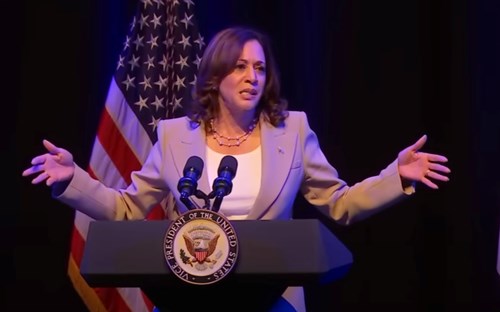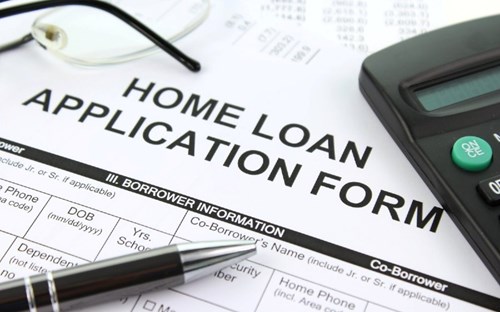An ABC News poll released over the weekend showed Donald Trump leading Harris by nine points on the economy, which the poll found to be voters’ top concern. Unbelievably, Harris is running in an even more liberal direction than Bidenomics. Key points of "Kamalanomics" include price controls, a $25,000 subsidy for first-time home buyers, and a $6,000 tax credit for new parents.
 The presumptive Democratic presidential candidate and current vice president has said her economic plan will reduce the cost of groceries, for example. But she doesn’t say why she will subject Americans to five more months of suffering and wait until Inauguration Day in 2025 to unveil it.
The presumptive Democratic presidential candidate and current vice president has said her economic plan will reduce the cost of groceries, for example. But she doesn’t say why she will subject Americans to five more months of suffering and wait until Inauguration Day in 2025 to unveil it.
Price controls? C'mon, man!
Bidenomics isn’t working, Joel Griffith, an economist with The Heritage Foundation, said on Washington Watch Friday. “Vice President Harris can’t separate herself from Bidenomics, and she continues to spout this propaganda about how wonderful our economy is,” Griffith told show host Jody Hice.
The economy has lost almost a million full-time jobs over the past year, and families have seen a roughly 20% increase in the cost of living over the last three years, he noted.
“Now if you look at some of the proposals she’s rolling out, it will actually double down on those Biden-Harris policies and make matters even worse. She’s talking about price controls now and about a massive influx of more spending in the housing sector that we know families are already struggling under the burden of because of the high home costs,” Griffith explained.
Former President Richard Nixon implemented price controls in 1971, but prices surged when he lifted them two years later. Locking in prices as a means of fighting inflation is akin to masking a symptom rather than treating the source of the problem, Reason.com reported.

“We know price controls do not work,” Griffith continued. “When you put an artificial cap on the cost of a good or service, what you end up with are fewer of those goods and services.”
Price controls also didn’t work for the Soviet Union in the 1980s. The government set prices but kept printing money which led to inflation. Bread lines stretched for blocks with some areas seeing shortages of bread and other essentials for extended periods of time.
“If you look at videos from the Soviet grocery stores during the 1980s, you recognize these prices were set low, but you couldn’t get many of the items. There was rotten meat, few fruits and vegetables. Of course, now you see price controls in effect in places like Cuba and Venezuela on groceries … and guess what – they don’t have much of a selection,” Griffith emphasized.
Harris’ ‘outright lie’ against grocers
 Harris has proposed a federal ban on “price gouging” (her term) by grocery stores that would enable the Federal Trade Commission to levy substantial fines against companies that engage in excessive price hikes.
Harris has proposed a federal ban on “price gouging” (her term) by grocery stores that would enable the Federal Trade Commission to levy substantial fines against companies that engage in excessive price hikes.
Griffith argued that's a solution in search of a problem. “It’s an outright lie. If you look at a chart of the costs to consumers of goods and services and you compare that to the costs to producers of goods and services, you notice something very interesting: the prices that producers pay have actually been rising even more rapidly than the prices that we pay.”
What that means, he explained, is that grocery stores, to some degree, have been eating the rising costs of food. Stores, he said, have not passed along the true costs of labor and other materials, he said.
“If companies are being greedy right now, they’re doing a very poor job of it,” Griffith added.
Housing costs guaranteed to rise
Harris’ plan to subsidize housing costs with $25,000 grants is another “example of flawed economics,” according to the economist. In the law of supply and demand, the administration has erred by putting too much emphasis on demand rather than supply, Griffith said.
“If we go ahead and cut everybody $25,000 checks for a home, guess what … that’s going to drive up the cost of those homes by roughly the same amount,” he said.
 The highest percentage increase in the housing market hits those trying to break in for the first time. A recent study by the real estate brokerage firm Redfin found the median cost for a starter home in June was $242,000 – an increase of 45% since 2020. First-time buyers need to earn $76,000 a year to afford the typical starter home, up 8% from a year ago.
The highest percentage increase in the housing market hits those trying to break in for the first time. A recent study by the real estate brokerage firm Redfin found the median cost for a starter home in June was $242,000 – an increase of 45% since 2020. First-time buyers need to earn $76,000 a year to afford the typical starter home, up 8% from a year ago.
“That’s why a lot of families are getting priced out of the market. This is going to drive up [the cost of] homes even more, and it’s going to add to inflation because we’re going to be borrowing and printing all those $25,000 checks,” Griffith said.
Higher prices busting out all over
Across-the-board prices have increased by about 20% in recent years, Griffith said.
“We know that families have added on average $4,000 of credit card debt over the past few years, and if you look at the rise of interest rate debt that has gone from 11% to 21%, the typical family is spending an additional thousand dollars per year on revolving debt cost.
“So add that together – a $4,000-a-year real wage cut plus $1,000-a-year borrowing cost. Then if you factor in the rising cost of home ownership, you see most families are actually suffering close to a $10,000 decline in real income,” Griffith said.







